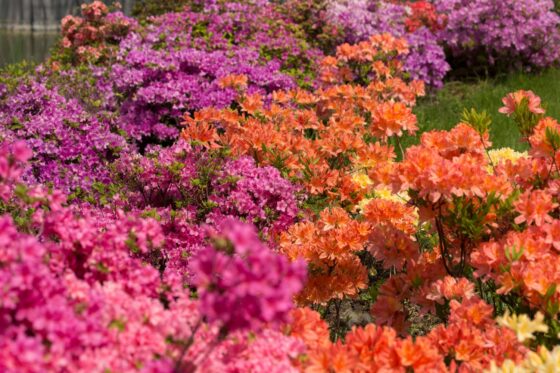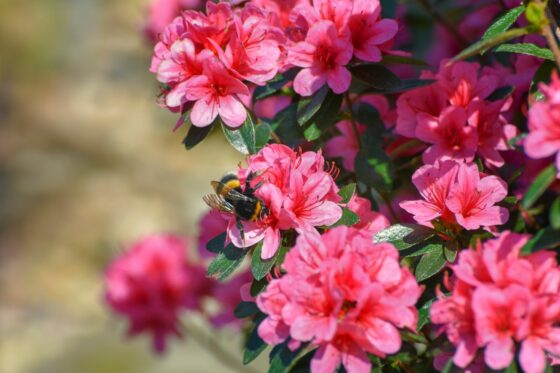Azalea: planting, location & winter care
Azalea delights with its bloom both in the garden and in the home. Here you can learn how to properly plant and overwinter azaleas.
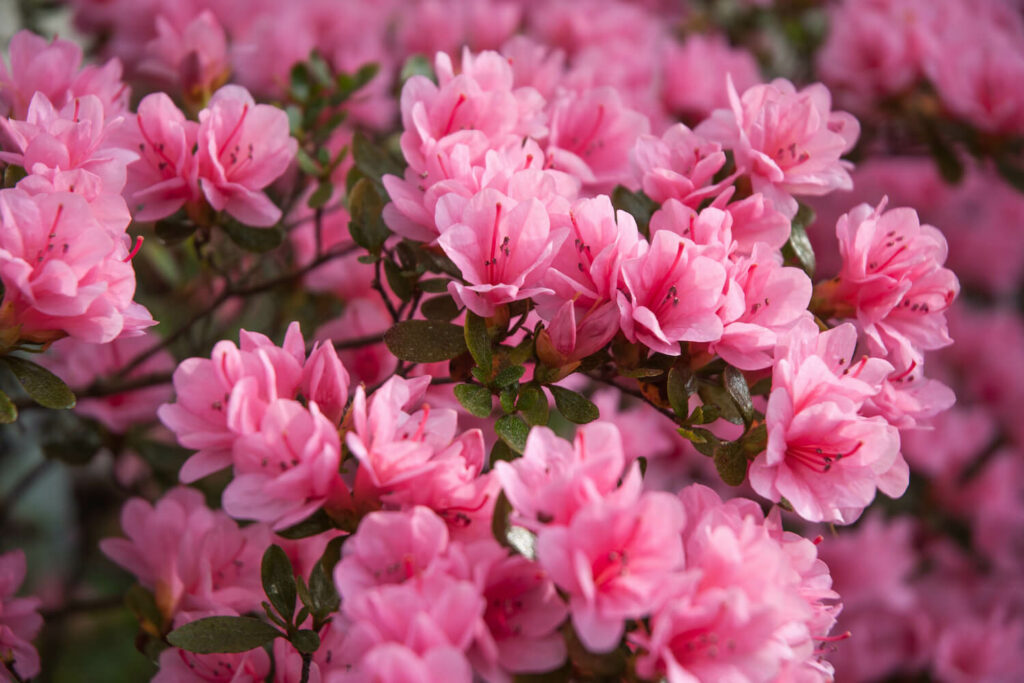
Since there are not only indoor but also garden azaleas, the location and care must be adapted to the appropriate needs of the species. We show how potted azaleas differ from outdoor azaleas and what to look for when planting azaleas.
Contents
Azalea: flower, origin and properties
Azaleas are woody plants of the Rhododendron genus and originate from Asia. However, they used to be considered as a separate Azalea genus. One of the special things about azaleas is that they can be kept both outdoors and indoors. The respective groups are called garden or outdoor azaleas and indoor or potted azaleas according to their characteristics. There are deciduous and evergreen representatives of woody plants. These all grow bushy and can reach heights of between 40 and 150 cm. The leaves have entire margins and are oval, glossy or even white flocked. Azalea flowers are striking and can bear a wide variety of colours. There are also varieties with filled, funnel-shaped flowers. Others have simple flowers. The flowering time of azaleas depends on whether it is a garden plant or houseplant. Indoor azaleas bloom earlier, sometimes from September to April. Garden azaleas, on the other hand, begin their blooming season in April and remain in bloom until August.
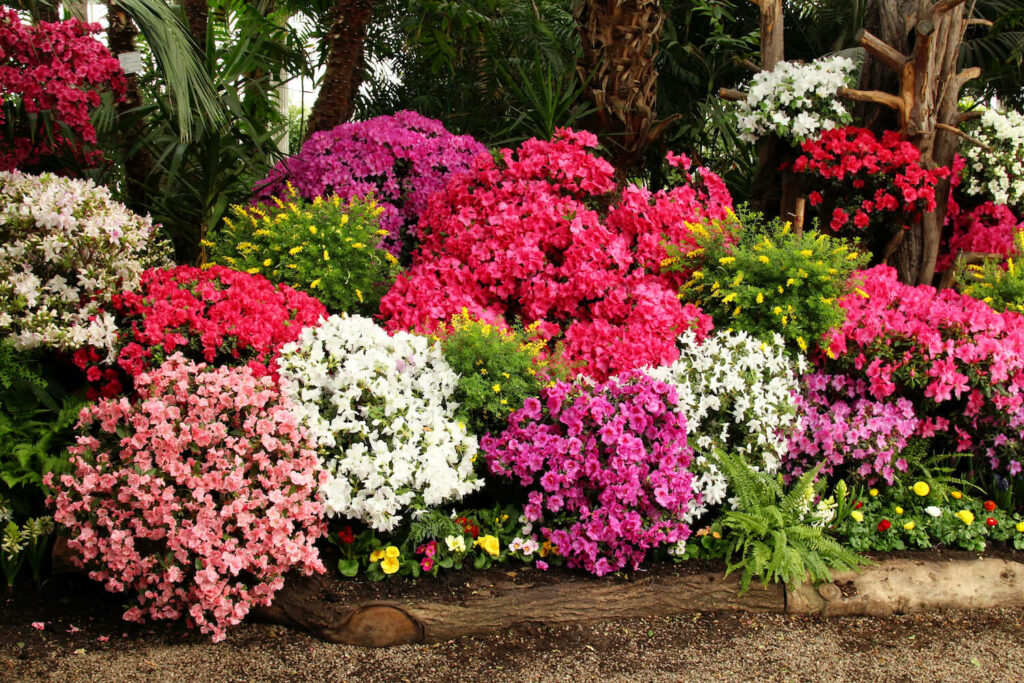
Difference between rhododendrons and azaleas: It is difficult to differentiate between an azalea and a rhododendron. All azaleas belong to the rhododendrons. Some Rhododendron species come under the name of azalea: frost-sensitive, evergreen indoor azaleas and hardy, winter or deciduous azaleas that thrive exclusively outdoors. Outdoor azaleas either shed their foliage or change their foliage dress annually in the spring. In contrast, rhododendrons are evergreen, changing their foliage consistently throughout the year rather than in batches in the spring.
Planting azaleas as houseplants
Once you have decided on an indoor azalea, there are a few points to consider. If you have chosen a suitable location and taken the right care measures, you will be rewarded with a lush bloom in the cold season.
Since azaleas are originally from mountain forests, they prefer a cool and humid climate. However, indoor azaleas have been appropriately bred and now tolerate warmer and drier conditions, such as those usually found in our homes.
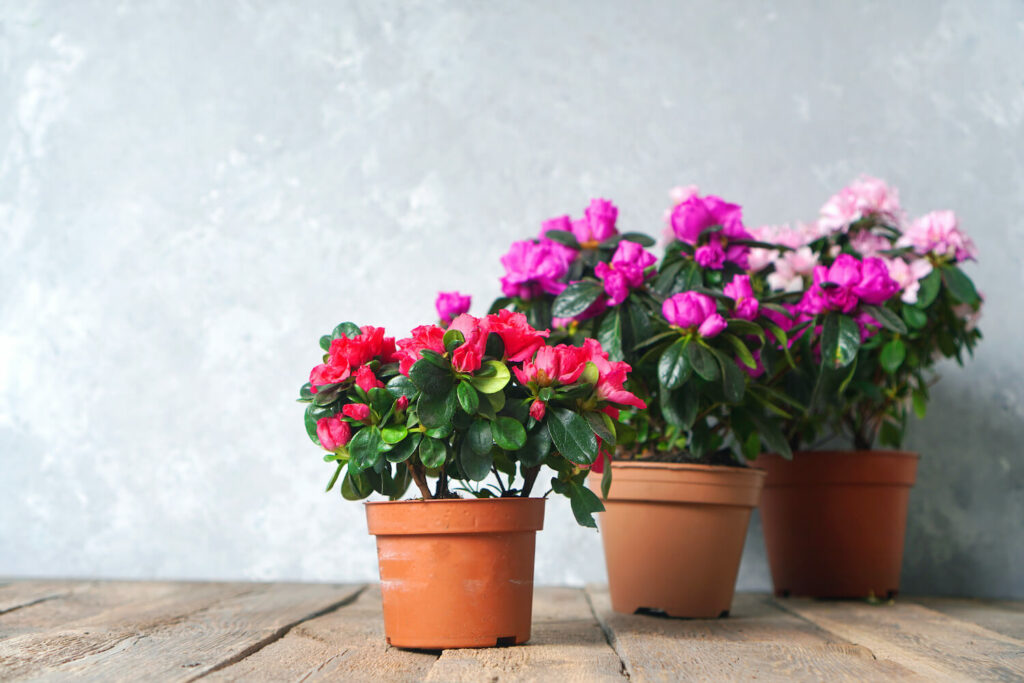
Find the azalea a bright location that allows direct sunlight in the morning or evening at most. The temperature should be between 12 and 18 °C. It is best to slowly accustom the plant to the indoor climate after purchase. To do this, first place it in a cool and semi-shaded location. Gradually expose it to more and more light and heat. At the beginning of the flowering period, the azalea can also be placed in a brighter, somewhat sunnier location, thus ensuring uniform flowering. A south-facing window or a windowsill above the heater, on the other hand, are not suitable. Here, the azalea is too warm and dry, and also does not tolerate drafts. Indoor azaleas like to spend the summer outdoors in a sheltered, slightly shaded place.
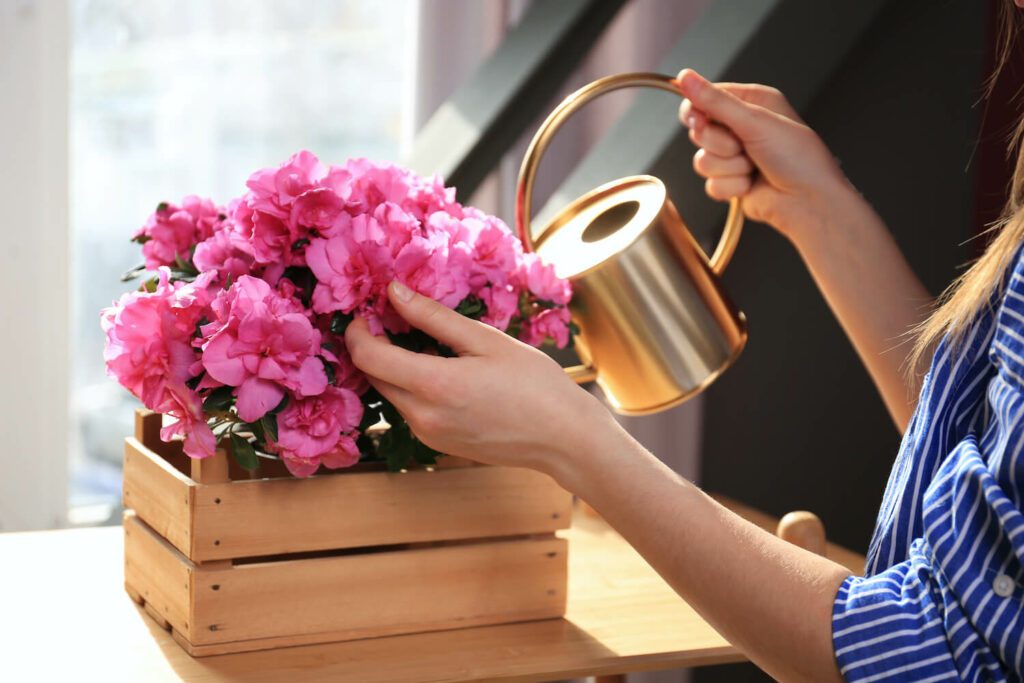
Azalea is slightly peculiar when it comes to substrate. It requires an acidic soil and is very sensitive to lime. A special bog bed substrate, such as our Plantura Organic Ericaceous Compost, is ideal. With a pH value of 4.0 to 6.0, this is in the acidic range and thus meets the requirements of the azalea. Our low-peat soil is made from natural raw materials and can be used both in beds and pots. Add a layer of expanded clay or clay shards into the planter beforehand to improve water drainage. The substrate should be kept moist at all times and never dry out or become waterlogged. Preferably use lime-free tap water or rainwater for watering.
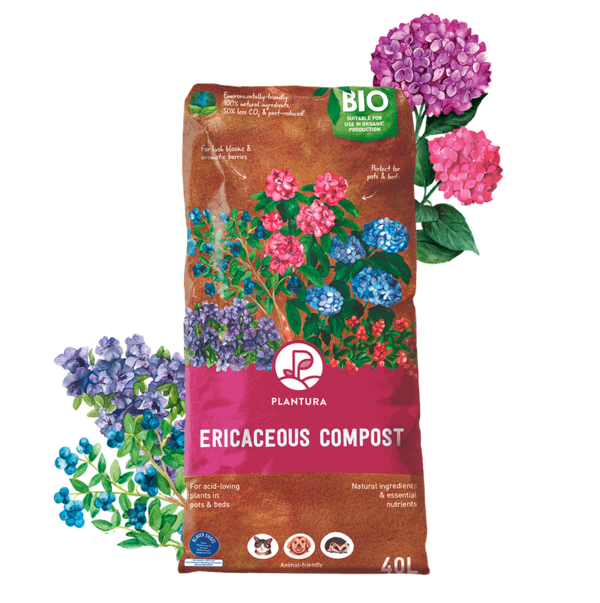
- Perfect for acid-loving plants such as hydrangeas, rhododendrons, blueberry bushes, azaleas & more
- Ensures all-round healthy plants with lush blooms and aromatic berries
- Peat-reduced & organic soil: CO2-saving composition
Tip: Since azaleas like high humidity, despite breeding you should regularly spray potted azaleas with lime-free water, sparing the flowers.
Planting azaleas outdoors
Some species do best outdoors and can spend all year outdoors due to their frost hardiness.
If you want to plant an azalea in the garden, a light or semi-shaded location without direct sun is excellent for it. The ideal azalea planting time is between September and November or between March and May. Dig a planting hole that reaches about four times the diameter of the root ball, as azaleas have pronounced shallow and wide roots. Fill the hole, which is about 40 cm deep, with an acidic substrate to provide optimal conditions for the azalea bush. Now, soak everything with lime-free water so that the contained peat can soak in. Finally, place the azalea in this marshy water-substrate mixture. If necessary, fill with more substrate and create a watering rim for optimal watering. The soil should be kept moist throughout the year. If you want to plant several azaleas, the planting distance should be between 30 and 100 cm, depending on the species and vigor.
In addition to regular watering, you should fertilise azaleas to provide them with nutrients. For this purpose, a special fertiliser for rhododendrons and azaleas that maintains the acidity of the substrate – for example, our Plantura Hydrangea Food is particularly suitable.
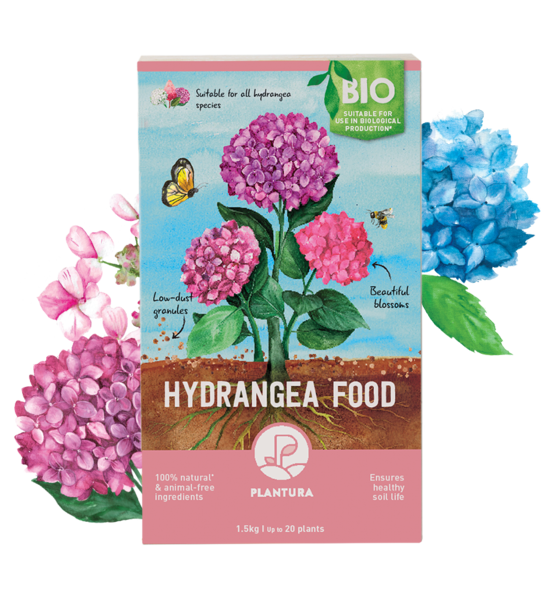
- For beautiful hydrangeas with lush blooms in pots & flower beds
- Prevents common deficiency symptoms & supports healthy plant growth
- Long-lasting fertiliser that is free from animal products - child & pet friendly
Overwintering: which azaleas are hardy?
Not all azalea species are hardy. Frost hardiness is basically determined by whether the species is deciduous or not. Deciduous species are mostly intended for outdoor cultivation and are also hardy. This means that they can simply stay outside in the winter. Evergreen azaleas are intended for indoor use and are not frost hardy. They need to be overwintered in a cool and bright place. Japanese azaleas and diamond azaleas, on the other hand, are outdoor azaleas that retain most of their foliage even in winter. Like deciduous azaleas, they are frost hardy.
Overwintering azalea indoors
Azalea houseplants require a cool and bright location in winter. The temperature may then drop to as low as 8 °C. At this time, it is important to ensure enough light. Before you put the azalea in its winter place, remove all dead flowers and fruit sets. Then, in the spring, place it outside so that it can thrive again in the next flowering season.

Overwintering azalea outside
Garden azaleas are hardy and can be left outside in winter. To make the cold season a little more comfortable for them, a layer of mulch is beneficial. This may consist, for example, of foliage. Mulch protects the soil and thus the roots from frost. A mulch layer is also useful in summer, as less water evaporates and it prevents weed growth. If the azalea is outside in a pot, it can also be mulched and the pot additionally wrapped with a jute bag or similar.
Azalea propagation
The easiest way to propagate your azalea is through cuttings. To do this, cut off about 15-20 cm long, slightly woody shoots. The best time for propagation is in early summer for indoor azaleas and from July to mid-September for garden azaleas. Use a sharp knife and cut at an angle if possible to increase the cut area. Water and nutrients will soon be absorbed here. The shoots should have leaves but not flower buds. Remove all leaves are except for the upper pair. Since the cuttings do not take root easily, the use of rooting powder is recommended. This stimulates root formation with the help of special plant hormones. Place the cuttings in pure white peat with a pH of 4.0 – 4.5, which is then moistened well. Alternatively, a dark container can be filled with water and the cutting placed there for rooting. Now, put a plastic bag over the pot to increase the humidity. This creates optimal conditions for the young plant. Finally, place the jar in a bright and warm place.

Tip: Azaleas can also be propagated via cuttings. With this method, the daughter plants initially remain on the mother plant and are separated only after root formation.
Azalea propagation by seed is also possible provided that fertilisation has occurred. Detach the seeds from the capsules and spread them directly on a suitable acidic substrate. Since azaleas are light germinators, the seed should not disappear under the substrate. Put the entire thing in a bright place where it is about 20-25 °C warm. Be sure to keep the humidity high with the help of cling film or a transparent cover. Germination should begin after about two to three weeks.
Are azaleas poisonous?
Azaleas are poisonous, as are most rhododendrons. Plant parts should not be consumed by humans or pets. Gloves are also recommended for safety when gardening.
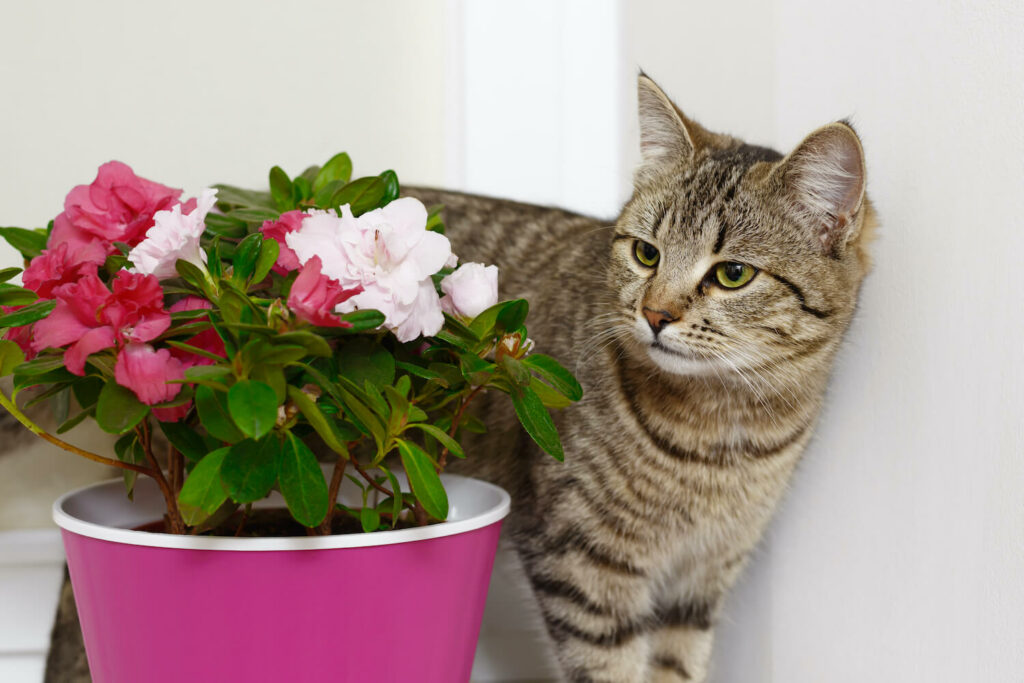
Common diseases and pests
The most common pests of azaleas include thick-mouthed weevils and spider mites; the latter are most common in dry indoor conditions. Mildew can also often look unsightly on the pretty ornamental plants. Some rhododendron cultivars and species, such as Rhododendron bureavii, naturally bear a mealy leaf coating, but this is not powdery mildew. Now and then rhododendron cicadas and rhododendron net bugs appear, leaving bright speckles on the leaves, whose sap they suck. Shoot death is caused by the fungus Phytophthora.
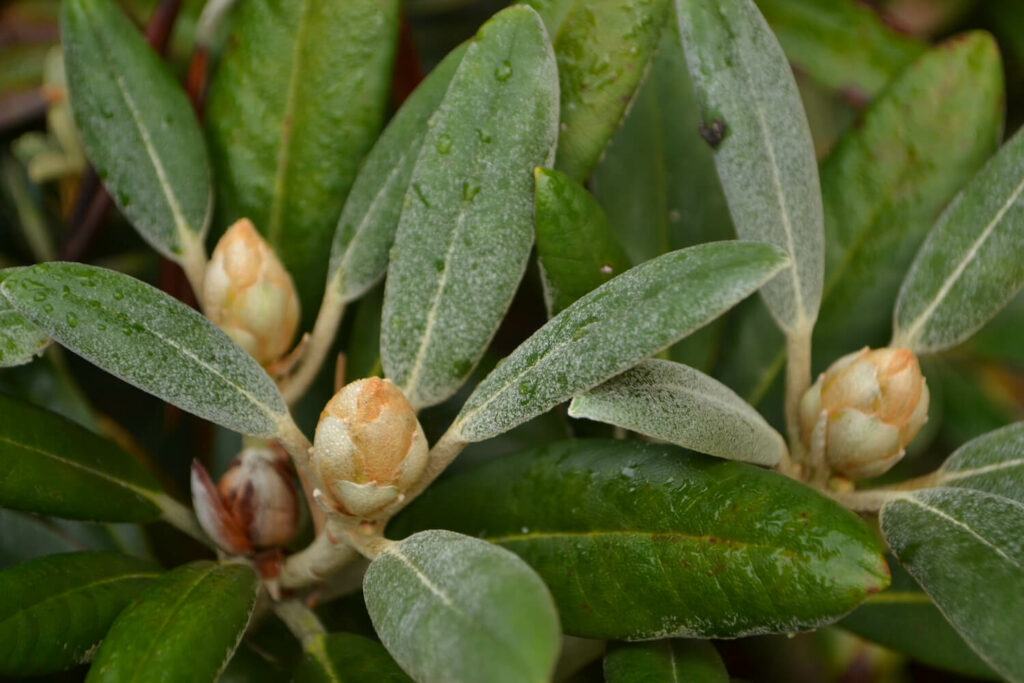
Would you like to learn more about the various azaleas? We explain how to care for azaleas and what you need to pay attention to help them thrive.



















